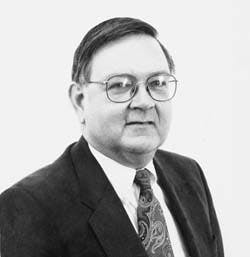TEAMWORK AND GEOSTEERING PAY OFF IN HORIZONTAL PROJECTS
Tom Schroeder, Dan Mathis
Baker Hughes Inteq
HoustonRon Howard, Guy Williams, Jimmy Sun
Pogo Producing Co.
Houston
The use of measurement while drilling data in real time and teamwork with open communication and quick decisions at the rig site ensured the success of a I five-well horizontal project in the Gulf of Mexico.
(Table 1 - Shallow Production From Similar Horizontal Wells In Gulf Of Mexico) In November 1993, Pogo Producing Co. successfully completed a five-well horizontal drilling program from the Eugene Island Block 295 B platform. These wells and a sixth vertical well, in zones previously thought uneconomical for development, encountered more than 7,000 ft of gas sand and tested at a combined rate of approximately 101 MMcfd.
The project team worked together to integrate various technologies, including geology, measurement while drilling (MWD), directional drilling, drilling fluids, and completion techniques. The project integrated a sized-salt mud system, MWD resistivity modeling, and rig-site geologic interpretation. The project's success was as much the result of excellent planning, communication, and teamwork as of technology.
Eugene Island Block 295 has an average water depth of 200 ft and is approximately 68 nautical miles south-southeast of Marsh Island La. The lease was purchased in December 1970 by Humble Oil Co. (now Exxon Co. USA) and came on production in February 1973. As of Jan. 1, 1994, the cumulative production has been approximately 2.9 million bbl of oil and condensate and 386 billion cu ft of natural gas from Pleistocene (Trimosina A and Angulerina B) sands. Currently, Exxon is the operator with an 80% working interest, and Pogo has the remaining 20%.
The horizontal wells on Eugene Island Block 295 B platform were designed to develop the three very shallow gas sands at about 1,200, 1,800, and 2,500 ft true vertical depth (TVD). The sands are referred to as AA-5, AA10, and AA-15, respectively (Fig. 1). Two of the horizontal wells targeted the AA-5 sand, two the AA-10, and one the AA-15. Pogo acquired 100% working interest of these sands by a farm-out from Exxon.
Block 295 lies close to the heart of the Pleistocene depocenter of the Gulf Coast geosyncline. Here, Pleistocene sediments are greater than 10,000 ft thick and are made up of marine and deltaic sands, silts, and clays.' The depositional sequence has been controlled by several major high and low sea level stands. Structurally, Eugene Island 295 is in an area characterized by deep-seated diapiric uplifts and depositional growth faults. Generally, the Plio-Pleistocene section is flat, but on Block 295 diapirs and growth faults have penetrated this section.
The three shallow gas sands are associated with a broad, low relief, anticlinal structure which has a very large gas productive areal extent, with each horizon covering more than 5,000 acres. Fig. 2 shows a structure map of the top of the AA-10 sand and the locations of the five B platform horizontal wells (labeled A-E) and the No. 6 vertical well over which the B platform was set. These sands appear to have been deposited in shallow water environments with very little variation in composition and appearance. Grain size is very fine to fine. Porosities are 30% or greater, with permeabilities measured in the darcies.
The horizontal target intervals planned for the Eugene Island 295 B wells were 1,500 ft long, and the geologic changes expected over this distance prompted the use of "geosteering." Geologic control is critical during geosteering. Geosteering is the use of geologic information such as MWD data to keep a well on target. In the Eugene Island 295 B project, successful geosteering was accomplished through communication among the geologist, directional driller, and MWD engineer at the rig site.
The geologist had to closely monitor the MWD logs while targets were drilled, and when the log response indicated shaliness, geologic interpretations about changes in structural dip or stratigraphy had to be made. The geologic interpretation could result in a decision to build, drop, or hold the inclination of the well. At the drill rates of 200-300 ft/hr in the horizontal sections, the geologist at the rig site had to make decisions quickly and communicate them to the directional driller to keep the wells on target.
DRILLING
Drilling a horizontal well requires close coordination of all members of the team. The well must be drilled within well-defined geologic target tolerances and in such a way as to maximize the quality of the MWD logs. In addition, the borehole must be constructed to optimize the completion and production of the well.
To minimize directional drilling problems, a mobile offshore drilling unit equipped with a top drive was selected. In addition, it was critical that ample liquid mud storage be available to support both the conventional mud system and the horizontal hole mud system.
MUD SYSTEM
A basic, partially hydrolyzed polyacrylamide (PHPA) mud system was used for the vertical and directional portions of the five wells.
The horizontal sections required a separate mud system to remove drill cuttings and minimize friction and formation damage.
An analysis of mud system case histories in Gulf of Mexico horizontal wells and the resulting well performances indicated that the two most commonly used mud systems were sized salt and mixed metal hydroxide (MMH). Based on initial production rates, these data indicated that a sized-salt system may have been the least damaging to Gulf of Mexico shallow sands (1,500-1,800 ft TVD subsea). Wells using sized salt had high production rates (Table i).
Consequently, the sized-salt mud was selected for Eugene Island 295 B platform wells and proved to be an excellent system for horizontal drilling. This drilling fluid is a polymer blend composed of xanthan gum and a cross-linked, hyroxypropylated, starch derivative used for suspension and fluid loss control. Other chemicals and sized salt were added to stabilize the system.
CASING PROGRAM
All five wells used a casing program of 24-in., 13 3/8-in., and 9 5/8-in. casing (Table 2).
Because of the shallow depths, the Minerals Management Service granted permission to install a 13 5/8-in., 10,000-psi blowout preventer stack on the 13 3/8-in. conductor strings. A 21 1/2-in. diverter was installed on the 24-in. drive pipe. Normal Gulf of Mexico leak-off tests were used to test the 13 3/8-in. and 9 5/8-in. casing shoes.
The 9 5/8-in. casing was set through the directional portion of the hole at angle builds from 4.5/100 ft to 6/100 ft. The casing design safety factors were increased, and buttress connections were used to compensate for the dogleg severity.
DIRECTIONAL PROGRAM
The directional section of each well used an 8-in. adjustable bent-housing downhole motor set at 1.6, and a 7-3/4-in. MWD tool for directional, gamma ray, and resistivity measurements. The standard 12 1/4-in. rock bits were designed for high weights and conventional rotary speeds. Short trips were made every 500 ft, with viscous sweeps before and after each short trip.
The angle was built to 87 at about 10 ft from the anticipated sand tops, then held at a tangent until the mud logger and MWD measurements confirmed that the target sand had been reached. At this point, the angle was increased to 901, the hole was circulated with viscous sweeps, and the bit was pulled. A 12 1/4-in. hole opener was then run to prepare the hole to receive 9%in. casing. The major difficulty encountered in this section of the hole was excessive gumbo; liquid inhibitors were added directly into the drill pipe on every connection. While not eliminating the problem, the inhibitors helped control the gumbo, especially on the hole opener trips.
HORIZONTAL PROGRAM
After the 9 5/8-in. shoe of each well was drilled out and a leak-off test performed, the PHPA mud system was displaced, and a casing cleaner was circulated to clean the 9 5/8-in. casing. The premixed, sized-salt drilling fluid was circulated for drilling the horizontal sections.
The horizontal sections were drilled with similar, but smaller, bottom hole assembly (BHA) components as used in the directional sections: a 6 3/4-in. motor set at 1.0-1.2, a 6 3/4-in. MWD tool, and an 8 1/2-in. rock bit.
Torque and drag analyses ensured the proper BHA configuration in each section of the hole. Short trips were again made every 500 ft with the hole circulated before and after. At total depth, the mud was displaced with brine water that was treated with fine sized salt, and the BHA was pulled out of the hole.
These horizontal sections were drilled successfully because of the teamwork of the drilling engineers, directional drillers, MWD engineers, geologist, mud engineers, and rig crews.
MWD
The MWD logs provided directional information gamma ray, phase difference resistivity (Rpd), and attenuation resistivity (Rat). R,,t has a greater diameter of investigation (7 ft at R, = 10 ohm-m compared to 4 ft for Rpd), whereas Rpd has a better vertical resolution (0.5 ft for Rpd in 10 ohm-m beds with 2 ohm-m shoulder beds compared to 1-2 ft for Ra ).2-3
Because of the BHA configuration, the MWD tool axis was about 1/4-1/2 in. from the center of the borehole while the horizontal sections were drilled. This BHA, combined with the low resistivity drilling fluid used in this section, made for accurate directional drilling, but the MWD resistivity logs suffered. At low mud resistivities (0.03 ohm-m) and high formation resistivities (10-100 ohm-m), if the MWD tool was not at the center of the borehole (that is, if the tool was eccentric to the well bore), the resistivity measurements became less accurate and could read too high.4 In addition, other environmental effects such as mud filtrate invasion or a noncircular borehole could amplify this effect. Despite these difficult conditions, the MWD logs provided excellent data for keeping these wells on target.
MWD downhole measurements were sent to the surface by mud pulse telemetry and displayed on a screen about 1 min later (nominal real time). Various preset combinations of data transmission were possible. Typically, Rpd and gamma ray were transmitted every 40 sec during rotation and every I'/2 min during drilling with the mud motor (sliding).
During sliding, more tool face measurements and fewer of the other measurements were transmitted. Rat was usually transmitted less frequently (about one value for every six Rpd values sent). A full see of more detailed data was recorded in the tool's memory at about 5-sec intervals, but these data were not available until the tool was out of the hole. At the actual horizontal drilling rates of 200-300 ft/hr, these measurements translated to "real time" transmission of R,d and gamma ray values every 2.5 ft during rotation and every 5.5 ft during sliding.
Before each horizontal well was drilled, model MWD logs were made to predict the log responses that would occur during actual drilling. To make these model logs, assumptions had to be made of the bed thicknesses and resistivities (Rt) that might be encountered as well as the relative dip of the beds. (Relative dip is the angle between the MWD tool axis and a line normal to the bedding plane.) These data were input to the dipping bed model.5-6
For example, the E well was designed to drill the AA-10 sand. The deep induction resistivity log from the No. 6 offset vertical well and the E well plan provided input for modeling (Table 3). The well plan called for a horizontal target at 2 ft TVD below the top of the 40 ohm-m bed, with a build rate of 4.5/100 ft.
Model results were then projected to the E well plan to provide a correlation log on a measured-depth scale for use at the rig site (Fig. 3). The well plan was extended to include an 87 section below the target to predict what the MWD response would be if the well approached the base of the sand. The model log shows "horn" responses. These horns are resistivity spikes that read much higher than the actual bed resistivities and occur at the top and base of the AA-10 sand. A horn response, if present, can give the MWD resistivity tool a look-ahead capability because the response will begin when the sensor is about 1.5 ft TVD from the top (and base) of the bed., Horns will occur at bed boundaries only if the resistivity changes abruptly (about a 10:1 change) and the tool is at a high angle to the bed (50).
In addition to the resistivity model, the gamma ray log was extremely useful for determining if the well was drilling in shale or sand. Because of the gamma ray tool's shallow depth of investigation (about 2 ft diameter), however, a change in gamma ray would occur just before or after a well has crossed a bed boundary. The plan was to use resistivity with its look-ahead capability to predict approaching bed boundaries and to use the gamma ray log for confirmation.
RESULTS
Fig. 4 shows the MWD real-time log from the E well. Before being plotted, the log curves were interpolated to remove gaps of less than 10 ft. Despite this interpolation, the Rat curve was sparse because, in real-time, it had a value only every 4 min (a value every 14 ft at a drilling rate of 200 ft/hr).
Near the top of the gas sand (830 ft) there was a slight drop in Rpd, and Ra, (with its high diameter of investigation) began to read high as it saw the approaching high-resistivity zone. At 850 ft, the increase in both resistivities and the decrease in gamma ray were clear indicators that the well was in the target sand. The horn response (Fig. 3) predicted by the model was not seen because the top of the sand exhibited a gradual increase in resistivity. This gradual transition from shale to sand could also be seen on the E well gamma ray log (Fig. 4, Track 1). This transitional resistivity profile replaced the model (Fig. 3) as the most likely log response to expect in the well drilled near the overlying shale.
The MWD resistivity and gamma ray sensors were about 45 and 50 ft behind the bit, respectively, during drilling to the casing point. This distance caused a gap in the data, and 'some of the missing data were obtained during a hole-opener run. This 45-50 ft measured depth offset represents about 4 ft TVD with well inclination of 85 at the casing point. Thus, as the MWD log began to show the approach of the target zone (resistivity increase at 840 ft), the drill bit had just entered the pay zone.
In the horizontal section, the MWD sensors were about 30 ft behind the bit. In this section, the Rat curve was missing, and the Rpd curve was "noisy." Both of these problems were caused by the eccentricity effect mentioned previously. This effect on the R,d curve was greatest at high resistivities, and as expected, there were more spikes when the apparent resistivity was above 30 ohm-m than when it was below this value.
At about 1,450 ft, the gamma ray increased, probably indicating that the well drilled through a shale bed within the AA-10 sand. This shale is probably thin, which explains why the gamma ray, with its small diameter of investigation (2 ft), was more affected than Rpd (4 ft diameter of investigation at 10 ohm-m).
By 1,530 ft, the R,d had dropped to about 10 ohm-m, which was interpreted as proximity to the overlying shale. (The MWD tool was probably about 2 ft from the shale because the resistivity tool sensed it but the gamma ray tool did not.) At this point the well inclination, which had built to more than 90, was leveled off at 900 and eventually dropped, starting at about 1,750 ft.
At 2,000 ft, the team decided to build angle to ensure maximum footage in the top of the AA-10 sand. At 2,070 ft, a close approach to the overlying shale was indicated by both a gamma ray increase and resistivity decrease. The well inclination was dropped to drill more of the target and then increased at 2,250 ft as the well approached its goal of 1,500 ft of productive interval. Near total depth the gamma ray increased, and R,d decreased as the bit exited the AA-10 sand at about 2,280 ft.
The D well had similar success. Both the E and D wells drilled about 1,500 ft of pay section in the top 5 ft of the AA-10 sand.
The B and C wells targeted the AA-5 sand. In the C well, the top of the sand was mostly shaled-out, and this well was steered down into the lower part of the sand, which was indicated when the resistivities finally increased to more than 3 ohm-m. Eccentricity effects were less than in the D and E wells because of the low formation resistivities of less than 10 ohm-m. The C well drilled 1,450 ft of gas sand while staying in a vertical window of 4-8 ft from the top of the sand. The B well had better results because the AA-5 sand was cleaner in this well. The B well drilled almost 1,900 ft of pay sand with resistivities of 4-12 ohm-m.
The last well (A) was drilled through more than 1,000 ft of pay interval in the AA-15 sand. Then the resistivities decreased, and the team was uncertain whether the well had drilled through the top or bottom of the target. The team decided to drop angle. When resistivities dropped below 0.7 ohm-m, it was apparent that the lower zone of the AA-15 sand, which was wet, had been penetrated. The well was then steered up into and through the target sand.
The two tops drilled by this well defined a bed dip of 0.5 in the direction of the A well. This dip was unexpected and illustrates the importance of geologic interpretation at the rig-site during geosteering. This additional drilling took about 8 1/2 hr, but it provided extremely valuable geologic information that was well worth the expense.
Fig. 5 shows a north-south cross section of the B platform wells. These five wells each drilled an average of 1,430 ft of gas sand while staying in 6-ft vertical targets.
COMPLETION
The five Eugene Island 295 B horizontal boreholes were drilled accurately and with minimal formation damage, which led to successful completion operations and gas production.
All five wells used 6 3/4-in. OD x 5-in. ID prepacked screens. A 3 1/2-in. OD wash pipe string was run inside using crossover circulating tools so that circulation could be established to the end of the gravel pack screen for cleanup operations. An hydraulic-set packer was set in the 9 5/8-in. casing at an angle of less than 50 to facilitate future wire line plug work.
After a prepacked screen was run to total depth and circulation established, a push pill followed by a breaker solution was spotted in each open hole to break the polymer cross link in the filter cake. Normal soak time was 6-8 hr. After soaking, the breaker solution was circulated out of the open hole using filtered seawater With 3% KCI to dissolve the sized salt from the well bore. This phase of the operation required 6-8 hr. Each well was monitored by constantly verifying the salinity of the returning seawater. When the salinity of the water pumped in equaled the salinity coming out, it was assumed that the majority of the salt was removed.
Each well was then completed with conventional 4Xin. tubing, completion tools, and wellhead. The wells were jetted in with nitrogen and tested prior to the setting of plugs and back pressure valves. A production deck was set after the drilling and completion operations were finished.
PRODUCTION HISTORY
The initial tests for the six Eugene Island 295 B platform wells included 101 MMcfd of gas (Table 4).
The five Eugene island 295 B horizontal wells have been on production since February 1994 (Fig. 6). Production was shut in for part of August to accommodate the drilling of a sixth horizontal well from the B platform. Some pressure decline caused the lower production in September.
The D and E wells produce at rates of almost 20 MMcfd from the AA-10 reservoir while the vertical No. 6 well is currently producing from the same reservoir at 5 MMcfd.
ACKNOWLEDGMENT
The authors thank the other Members of the team, particularly TBC-Brinadd, for their technical contributions. The authors thank Frank Radez with Baker Hughes Inteq for his editorial contributions. An abstract of this article was originally presented as a poster session it the Society of Petroleum Engineers Annual Technical Conference and Exhibition in New Orleans, Sept. 23-26, 1994.
REFERENCES
1. Sawyer, W.B., "Thickness of Pleistocene and Neogene Rocks," Ocean Margin Drilling Program Regional Atlas No. 6: Gulf of Mexico, pp. 18-19, Marine Science Institute, Woods Hole, Maine.
2. Barnett, W.C., and Meyer, W.H., "Radial Response of a 2-Mhz MWD Propagation Resistivity Sensor," 66th Annual Technical Conference and Exhibition of the Society of Professional Engineers, Dallas, Oct. 6-9,199 1.
3. Wisler, M.M., "Real-Time Electromagnetic Propagation Resistivity and Memory for MWD," 11th European Formation Evaluation Symposium, Oslo, Norway, Sept. 14-16,1988.
4. Wu, J.Q., and Wisler, M.M., "Effects of Eccentering MWD Tools on Electromagnetic Resistivity Measurements," Society of Professional Well Log Analysis 31st Annual Logging Symposium, Lafayette, La., June 24-27, 1990.
5. Wu, J.Q., Wisler, M.M., and Barnett, W.C., "Bed Boundary Detection Using Resistivity Sensor in Drilling Horizontal wells," SPWLA 32nd Annual Logging Symposium, Midland, Tex., June 16-19, 1991.
6. Anderson, B., Bonner, S., Luling, M.G., and Rosthal, R., "Response of 2 MHz LWD Resistivity and Wireline Induction Tools in Dipping Beds and Laminated Formations,' SPWLA 31st Annual Logging Symposium, Lafayette, La., June 2 -27, 1990.
Copyright 1995 Oil & Gas Journal. All Rights Reserved.





